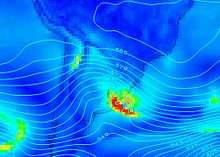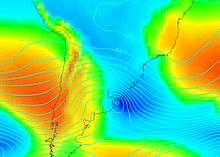2005 storm in Uruguay
| Type | Extratropical cyclone |
|---|---|
| Formed | August 23, 2005 |
| Dissipated | August 24, 2005 |
| Lowest pressure | 980 mb (28.94 inHg) |
| Highest winds |
|
| Damage | Severe |
| Casualties | 10 in Uruguay, 2 in Argentina |
| Areas affected | Southern Uruguay |


Facts
In 2005, a heavy storm swept across southern Uruguay from 23 to 24 August. The storm started at the River Plate, entered Uruguayan territory at Kiyú (San José) and moved towards Juanicó (Canelones), where it died down.[1]
This storm produced strong winds which exceeded 187 km/hr. Destruction was severe in the affected cities in Uruguay and Argentina.[1]
Aftermath
Meteorologists considered this to be an extratropical cyclone.[1]
Many years later, Uruguayan people keep commenting this cyclone as the worst they remember.[1] The 2005 storm is widely regarded as the worst disaster to befall Uruguay in recent years, even prompting United Nations intervention. The storm cause most of its serious damage in Canelones, Montevideo, San Jose, Colonia and Maldonado. These combined cities contain about 70% of the entire country's population. Reestablishment of public services was slow due to a lack of resources, including power saws, emergency shelter, and other essentials like mattresses, blankets, sheets, hygiene kits, and diapers.[2]
10 people were reported dead, including two teenagers who died when an antenna was blown into their house. Three people were killed by an uprooted trees, displaying the severe winds that were associated with this storm.[3] and dozens were injured, a high number of fatalities for a small country like Uruguay. In addition to this, thousands of homes were damaged with most of the damage occurring to roofing. Over 20,000 people lost electricity and phone service.[4] The same storm in Argentina cause two deaths and forced the evacuation of 2,400 people in downtown Buenos Aires.
Culture
Each year as the end of August nears, Uruguayans and Argentinians prepare for "La Tormenta de Santa Rosa" or the Santa Rosa storm. According to local legend, this storm is predicted to occur anywhere from five days before or after August 30, which also happens to be the annual celebration of the festival of Santa Rosa. The legend originated from the belief that Isabel Flores de Oliva concocted a deadly storm to prevent Dutch pirates from attacking the city of Lima in 1615. It is believed by locals to be the deadliest storm of the year.
This particular storm is believed by many to be the Santa Rosa storm of 2005, despite the fact that it occurred on the six to seven days before the 30th of August. The Santa Rosa storm does not necessarily have to be an extratropical cyclone, and usually is not.
See also
- 2012 storm in Uruguay
- Santa Rosa storm
- Climate of Uruguay
References
- "2005 cyclone much worse than 2012" (in Spanish). El Observador. 20 September 2012. Archived from the original on 21 September 2012.
- "Uruguay: Heavy Storm OCHA Situation Report No. 1". ReliefWeb. Retrieved 2015-11-20.
- "Wind and rain storm kills seven in Uruguay". MercoPress. Retrieved 2017-05-04.
- CMB.Contact@noaa.gov. "Global Hazards - August 2005 | State of the Climate | National Centers for Environmental Information (NCEI)". www.ncdc.noaa.gov. Retrieved 2017-05-04.
External links
- Official report on the 2005 storm (in Spanish)